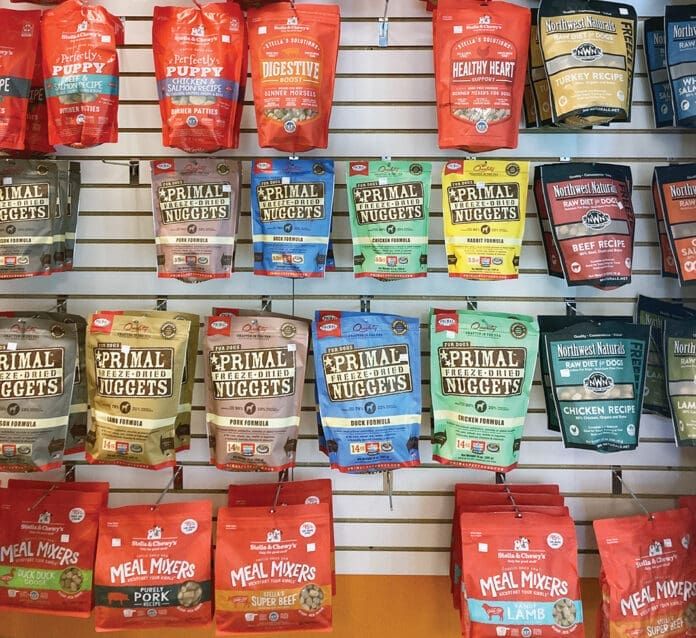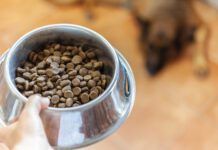It’s getting increasingly difficult to neatly categorize and select the best non-kibble dry dog foods. Freeze-dried foods, which once seemed novel, are now quite common, either as stand-alone diets or as meal “toppers” or treats. There are also ever-more dog diets being made with dehydrated meats.
Obviously, we include dehydrated diets—which range from low-moisture, powdery or muesli-like products, to chewy, jerky-like products with moisture levels that are a bit higher (12% to 14%) than those seen in kibble (usually, 9% to 10%)—in the same review category as freeze-dried. After all, these products all have a high inclusion of raw meat and animal organs (such as heart, liver, kidneys, lungs, and tripe), and just a few other ingredients.
Today, though, we’re seeing a burgeoning number of diets that incorporate freeze-dried or dehydrated raw meats but that are made in truly innovative ways, resulting in some novel, niche-defying products. Some contain higher inclusions of carbohydrate sources than most freeze-dried diets; some even resemble kibble in appearance and texture! “Cold-pressing,” steaming, and air-drying processes have also become much more common methods for manufacturing foods that are as lightly processed as possible, leaving the vitamins and vital enzymes in the products minimally damaged or reduced.
Best “All Life Stages” Freeze-Dried/Dehydrated Dog Food
For this category, we chose only products that are complete and balanced for dogs of all life stages, including the growth of large-breed puppies
Stella & Chewy’s Meal Mixers Chicken Variety
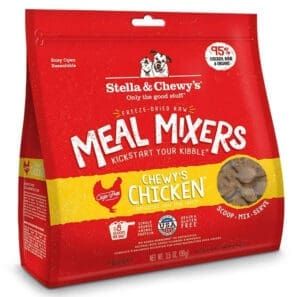
First 10 ingredients: Chicken with ground bone, chicken liver, chicken gizzard, pumpkin seed, organic cranberries, organic spinach, organic broccoli, organic beets, organic carrots, organic squash.
Protein: Min 48%
Fat: 28%
Calories: 4,440 kcal/kg
Cost: $1.94/oz
Runners up:
Bixbi Pet’s Rawbble Freeze-Dried Chicken Recipe
Open Farm’s Homestead Turkey Freeze-Dried Raw Dog Food
Best “Adult Maintenance” Freeze-Dried/Dehydrated Dog Food
Primal Pet Foods Freeze-Dried Raw Pronto Beef Recipe
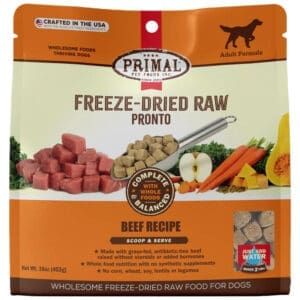
First 10 ingredients: Beef (with ground bone), beef livers, organic carrots, organic squash, organic kale, organic apples, organic parsley, organic pumpkin seeds, organic sunflower seeds, organic blueberries.
Protein: Min 41%
Fat: 18%
Calories: 3,905 kcal/kg
Cost: $2.40/oz
Runners up:
Instinct Raw Longevity 100% Freeze-Dried Raw Meals Cage-Free Chicken Recipe
Kiwi Kitchens Raw Freeze-Dried Chicken Dinner
Best Lower-Fat Freeze-Dried/Dehydrated Dog Food
As we stated in the main article, this category of foods tends to be very high in protein and fat, making it difficult (but not impossible) to find one of these products for dogs who require a low-fat diet.
Fresh Is Best Bulk Freeze-Dried Dog Food Mix, Chicken Variety
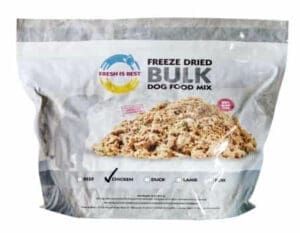
First 10 ingredients: Chicken, chicken hearts, chicken liver, chicken gizzards, yams, apples, kale, collards, fish bone meal, dried kelp.
Protein: Min 45%
Fat: Min 10%
Calories: 3,946 kcal/kg
Cost: $1.56/oz
Runners up:
Only Natural Pet EasyRaw Cage-Free Turkey & Sweet Potato Feast Dehydrated Dog Food (Min 8% fat)
Dr. Harvey’s Grain-Free Chicken & Garden Veggies (Min 7% fat)
Best “Budget” Freeze-Dried/Dehydrated Dog Food
Many of the least expensive products in this category are made by The Honest Kitchen, who makes our overall favorite product. How do they do it, while using only human-grade ingredients and manufacturing in human-food manufacturing plants? Perhaps it’s because they’ve been making these products for longer than just about any other company.
The Honest Kitchen Dehydrated Gourmet Grains Chicken & Duck Variety
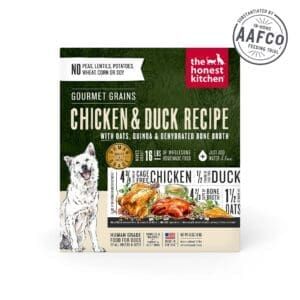
First 10 ingredients: Dehydrated chicken, organic barley, organic oats, flaxseed, dehydrated eggs, dehydrated carrots, dehydrated duck, dehydrated pumpkin, dried organic coconut, organic quinoa.
Protein: Min 30%
Fat: 16%
Calories: 3,908 kcal/kg
Cost: $0.59/oz
Runners up:
Grandma Lucy’s 3 Bears Freeze-Dried Dog Food, Chicken Variety ($0.50/oz)
Only Natural Pet MaxBlends Grain-Free Beef Dehydrated Dog Food ($0.76/oz)
Shared Traits of Dried, Dehydrated, and Freeze-Dried Dog Foods
First, all of these products are made with relatively low-temperature, slow processes that remove moisture from fresh ingredients while protecting and preserving their nutrients. The removal of moisture not only creates shelf-stable products, but foods that are light and inexpensive to ship.
Shipping might be the only thing that is inexpensive about them, however. The pet food makers who compete in this category tend to use very high-quality ingredients; many of them contain human-grade meats (the legal term is “edible”) and organic produce. And both freeze-drying and dehydration are energy-intensive processes; these foods are not cheap to make, so they are not cheap to buy, either.
However, the makers of these products would hasten to tell you that due to the superior digestibility and high energy density of these products, the cost of using them to meet your dog’s nutritional requirements is comparable to—or even less than—the cost of feeding a fresh refrigerated, canned, or frozen raw diet.
All of these products contain mostly meat and other animal ingredients (including organs, ground bone, and plasma or blood products). Many of the companies claim that their products consist of 80% or more animal protein sources; some claim to contain as much as 95%! The resulting diets are highly digestible and highly palatable.
Also, most of the products that we are lumping together in this category have a very low carbohydrate inclusion. Remember, dogs don’t require carbs; they can live on fat and protein alone, as long as they get the vitamins and minerals they need.
But also keep in mind that if you don’t include carbs in a diet, only protein and fat remain, and that fat contains more than twice the calories as protein or carbohydrates. (Carbohydrates and protein both contain 4 calories per gram; fat contains 9 calories per gram!) Many of these products may contain more fat than is healthy for dogs who are overweight and/or sedentary, or who are intolerant of fat (such as dogs who are prone to pancreatitis).
Selection Criteria for Dehydrated or Freeze-Dried Dog Foods
“Well,” you may be saying. “These foods sound like a nice addition to my dog’s diet—or a replacement for my dog’s current diet. How do I choose which ones might work best for me and my dog?” Here are some bullet points to consider when making your choices:
For most of us, price will be a consideration. The high cost of these foods might not matter if you have one or two very small dogs or one very precious larger dog, or if you’re wealthy. But I couldn’t afford to feed them all the time to my two large dogs!
That said, I love having some on hand to use as treats and food toppers (to boost nutrition and the palatability of their regular food). And when I’m fostering sickly shelter dogs, freeze-dried foods are my magic remedy; I’ve helped all sorts of sick puppies back from the brink with these high-quality diets. So, though I could not afford to feed them full time, I fit a certain amount of these products into my monthly dog-food budget. You have to do what works for you.
Ingredients that work for your dog. It should be obvious, but you have to check product labels to make sure that any prospective diet doesn’t contain ingredients that are problematic for your dog. Is he allergic to or intolerant of certain proteins? (Are you keeping a food calendar or journal of what you feed and how your dog looks and feels? That’s the best way to learn about and keep track of that.)
Fortunately, many of these diets are limited-ingredient, with single sources of animal proteins in each formula. It’s much easier to find foods with a small number of ingredients in this category than in kibbled products.
Appropriate protein and fat levels. Look at the guaranteed analysis of any product you are considering. These diets are high, high, high in protein and fat. They can be just the thing for thin, young, active dogs, sport dogs, working dogs, and pregnant or nursing dogs, but they are likely not a great idea for your couch potato Labrador or the Dachshund who gains weight from breathing.
Complete information about products on the company website; ease of contacting company. In our view, there is absolutely no excuse for a company to fail to inform consumers about the nutritional adequacy of its products. If you are in the nutrition business, provide basic nutrition information!
We actually cut a few companies who have been on our “Approved Foods” list in past years for lacking basic information about their products on their websites or labels such as “nutritional adequacy statements.” These statements tell consumers which criteria the food met in order to qualify as a “complete and balanced diet” for dogs, and, importantly, which dogs the food is intended for. Adult dogs only? Dogs of all life stages? What about large-breed puppies? This statement is the bare minimum—and companies that don’t display this information for each of their products shouldn’t even be considered, in our opinion.
We feel equally strongly about companies that make it difficult to reach them. A few don’t publish their phone numbers anywhere; we’re not fans of this (though we haven’t eliminated a company from our consideration for this alone—yet). Some do publish their numbers but don’t answer their phones or return calls left in voice mailboxes! One company we called recently had a full phone mailbox—for days!
Ease of purchasing. Some of these products can be found in chain pet supply stores and online retailers. Others are sold only in independent pet supply stores and some can be purchased by subscription and are direct-shipped. All of these methods have pros and cons.
Approved Freeze-Dried/Dehydrated Foods
If you’re ready to try some of these products, we’re giving you dozens of candidates to choose from. Whole Dog Journal’s 2024 List of Approved Freeze-Dried and Dehydrated Dog Foods includes companies that make diets that meet our selection criteria, which can be abbreviated thusly: No unnamed meats or fats; only whole, lightly processed, “real food” ingredients; and no artificial colors, flavors, or preservatives.
You can access information about the companies on our list in two ways:
1. Subscribers can download a PDF that contains contact information for each company, as well as information about their offerings in this dog-food category: how many varieties they make for dogs of each “life stage” (adult maintenance or “all life stages”), and the range of protein and fat that their products contain. This information is important, because virtually all of the products in this category are high in protein and fat. It might be impossible to find an appropriate diet in this category for a dog who cannot tolerate high fat levels.
We’ve also given the first 10 ingredients of at least one variety that each company makes. In most cases, we chose a beef-based variety, so similar products could be compared side by side. If the company offers several lines of disparate products, we highlighted the ingredients of two or three products made by that company.
2. Subscribers can also use our searchable database to look at in-depth information about each product made by the companies on our “2024 List of Approved Freeze-Dried and Dehydrated Dog Foods.” This information gives the full ingredient list of each product made by each approved company, as well as each product’s protein and fat content; whether its nutritional adequacy was proven by AAFCO’s “nutrient levels” requirement or a feeding trial; what “life stage” it’s formulated for (adults only or dogs of all ages, including whether it’s appropriate for large-breed puppies or not); whether it is grain-free or grain-inclusive; and whether it was made by freeze-drying, dehydrating, or some combination of the two. The searchable database also provides a link to a location where each product can be purchased. Note: Whole Dog Journal is reader-supported. If you purchase food through links on our site we may earn a commission. Whole Dog Journal does not accept money for its food and product reviews.
The best part about the searchable database is that you can use various filters to find foods that do or do not contain certain ingredients or that contain more or less than a certain amount of protein and/or fat. You can sort the database by the names of the companies or by the price of the individual products, as you wish.
We’re excited about the possibilities of this searchable database, and hope you find it to be helpful for finding good foods for your dogs. Keeping your dog’s individual needs in mind, try some new products, switch frequently – and always watch your dog! Note the date that you start feeding any new food on a calendar and record your dog’s physical responses to the switch, good and bad. If you pay attention, he’ll let you know what works for him (and what doesn’t) with his appetite, energy, skin and coat, stool, and weight.


